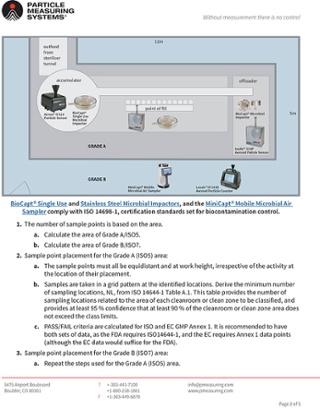Choosing the Most Suitable Particle Sample Point Locations in the Cleanroom

As environmental system designers, we are often asked where to place sample points for particle monitoring, whether it be performed in a pharmaceutical cleanroom or clean device (RABS, isolator, etc.).
The answer is not always straightforward. There are several guidance documents that offer advice on what processes need to be monitored, along with advice on suitable distances from the process being monitored. The goal of this article is to identify the considerations, establish the most suitable location for monitoring a process, and build a scientific rationale for that decision.
Particle counting in pharmaceutical applications can be clearly segregated into one of three categories: certification, qualification and monitoring. Each category requires a different approach.
Certification is measuring a cleanroom for a standard. The only standard recognized worldwide is ISO14644-1, “Classification of air cleanliness by particle concentration”, which defines how a cleanroom performs and its ability to show uniformity across the entire space. This is done irrespective of the activities performed in it.
Qualification is the process of analyzing risk assessment for the activities in the room. Qualification follows grid methodology testing methods. Particle counts are measured in both operational and at-rest states; however, the operational data is the most valid.
Monitoring is the ongoing sampling of the cleanroom on a frequency relative to the degree of control required to prove management over risk to the finished product. The number of sample points and their location is determined by risk assessment, and the qualification and certification process.
Certification
As mentioned above, cleanroom certification is based on ISO14644-1, “Classification of air cleanliness by particle concentration” standards. The specifics of the assessment may vary slightly for FDA or EU GMP regulations, but the underlying methodology is standard.
Certification demonstrates that the entire area meets a specific ISO classification by particle concentration. That is, irrespective of the final use of the room, the design and implementation of the filtration system are considered. The international standard means that a cleanroom tested to meet compliance for ISO 5 standards will meet that standard independent of geography and regulatory aspects (i.e.: FDA or EU GMP). This provides a universal standard to show that a cleanroom level has been established. Particle Measuring Systems’ products, including the Airnet® II Particle Sensor and IsoAir® 310P Aerosol Particle Sensor, comply with new ISO standards set in 2015. The interactive software of the Lasair® III can even step the user through the certification process.
There are many different resources to prove ISO compliance and this paper will not cover these in depth. However, using the example of a classic filling machine (Grade A/ISO5) within a Grade B (ISO7) background area, the basic rules of testing can be demonstrated.
Interested in learning more? Complete the form on this page to receive a free copy of the Choosing the Most Suitable Particle Sample Point Locations application note.
